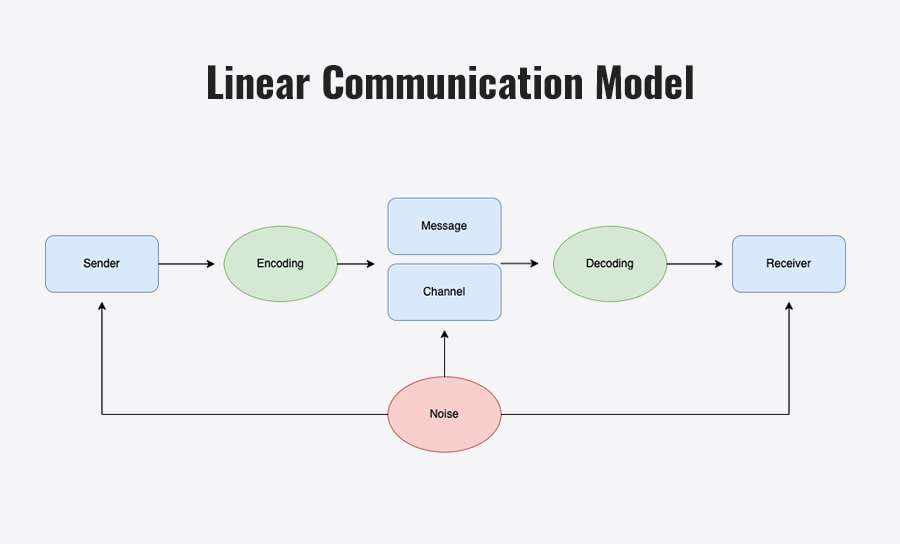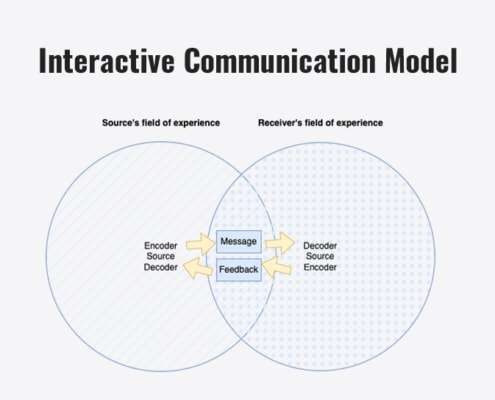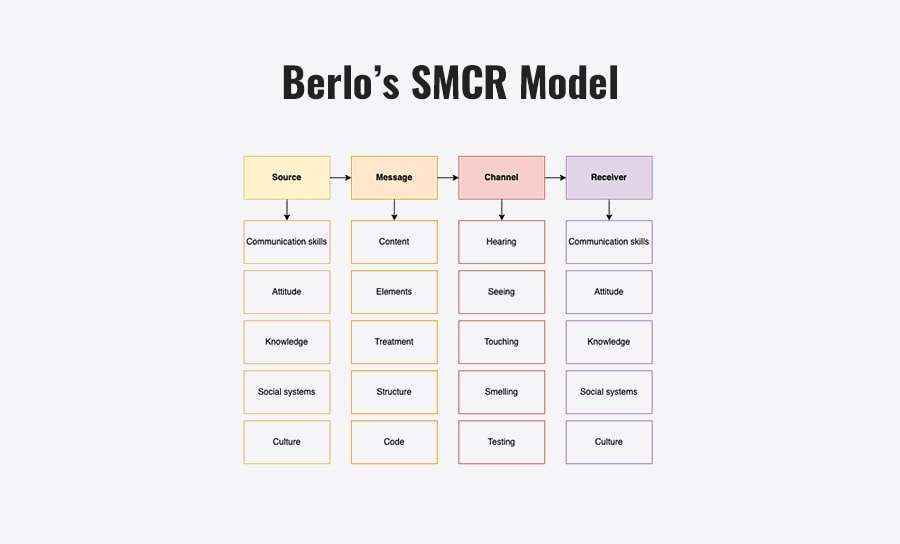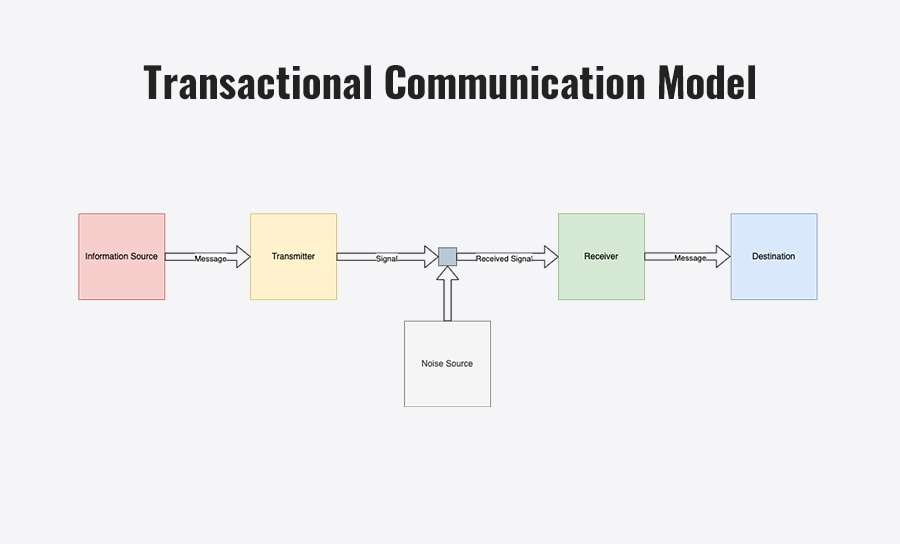Communication is key: Pretty sure you’ve heard this phrase before. Whether it’s in everyday situations, relationships or in the workplace – The ability to communicate in the right way will allegedly save you a world of troubles. But what is communication? And how should you improve it in the first place?
We’re here to find the answers to these questions. After reading this extensive guide, you’ll have a clear definition of communication, know which interpersonal communication models are worthwhile, and how to develop your communicative skills. Being teamwork enthusiasts, we are especially interested in communication in a business context, which is what we will pay closer attention to during the latter part of the article. Let’s jump in!
The topic of communication is a vast one, so let’s break it down to its fundamental meaning. Essentially, communication is the process of exchanging information between two or more people, animals, or machines. It’s how we share our thoughts, ideas, and feelings with others. Communication can happen through various means, including speech, writing, body language, or even technology like texting or video conferencing. It is also an important factor in team development, as knowing about communication can help to understand the dynamics within a group or team better.
So without communication, basically nothing works out in our everyday lives. Effective communication is crucial in both personal and professional relationships. It helps to build trust, resolve conflicts, and foster understanding. When we communicate effectively, we can convey our message clearly and ensure that it’s received in the intended way. Communication is the foundation of all relationships, and mastering it can help us achieve success in all aspects of our lives.
How does communication work? (Communication Process)
Trying to explain how communication exactly works is hard to do. It is a complex process that involves several elements, including:
Those are the basic players in interpersonal communication. Keep them in mind, as we will come back to them when discussing communicative models. In short: Communication goes both ways. The sender is the person or entity that initiates communication, while the receiver is the one who receives the message. The message in communication is the information that the sender wants to convey, and the medium is the channel through which the message is sent, such as speech, writing, or gestures.
To communicate successfully, the sender and the receiver must share the same code. This means choosing the right words, tone, and body language to convey the intended meaning. The receiver must then decode the message by interpreting the information they’ve received and understanding the sender’s intent. When two speech participants have a different code, this may be caused by cultural differences, language barriers or distractions. It’s essential to be mindful of these factors and adjust your style accordingly, to achieve the goals of communication.
Effective communication: Why is it important?
Behold! Just because a communicative process is going on, does not mean the communication is effective. For communication to be effective, information, ideas and thoughts need to be exchanged in a clear and concise way to make sure it is received and understood as intended. It involves listening actively, speaking clearly, and being mindful of the recipient’s background and perspective.
Effective communication is essential for building and maintaining relationships, especially in a professional context, where time is often of the essence. When communication is clear and direct, it reduces misunderstandings, conflicts, and misinterpretations, and helps establish trust and respect. By being a good communicator, you can convey your thoughts and feelings accurately and respectfully, and make meaningful connections with those around you.
As a remote company, we are very aware of our communication, and make sure we interact effectively. This is why we have dedicated tools for written communication (e.g. Slack), video conferences (e.g. Remote Workspace) and the preservation of knowledge (e.g. Notion).
Barriers to Effective Communication
Effective communication can be hindered by a variety of barriers, such as the following examples:
- Language barriers: Language differences can make it hard (or impossible) to understand each other. This can include differences in dialect, accents, or technical jargon.
- Physical barriers: Physical barriers include distance, noise, or technology issues that prevent effective communication.
- Emotional barriers: Emotional barriers are harder to target or influence, and are highly individual. They can include differences in mood, attitude, or personality that may affect communication.
- Cultural barriers: Cultural differences can affect communication by influencing how people interpret and understand information. Different cultures can have different values and ways they see the world, which you have to keep in mind when communicating cross-culturally.
- Perception barriers: Perception barriers can include biases or assumptions that people have about each other, which can lead to misinterpretation or misunderstandings.
- Lack of feedback: Lack of feedback can make it difficult to know whether communication has been understood, and can prevent effective communication from taking place. However, also be careful to give constructive feedback (see also: 360 degree performance feedback).
- Information overload: Be concise with the information you give someone, especially when the matter is urgent. Information overload can occur when too much information is shared, making it difficult to process and understand.
Understanding these barriers and taking steps to overcome them can help to improve communication and ensure that information is being effectively transmitted and received.
Communication: Verbal and nonverbal
Communication is an essential aspect of our daily lives, and there are different types of communication we use to convey messages. Besides the classic verbal communication we perform when having a conversation with someone, nonverbal communication is also essential for bringing across your points and correctly understanding others. Many experts even argue that nonverbal cues are even more important than the actual words we speak. Not a clue what the difference between verbal and nonverbal communication is? Let us explain.
Verbal communication
Verbal communication is pretty straightforward: We communicate verbally when we use words, spoken or written, to convey a message from one person to another. We use our language to express ideas, emotions, opinions, and thoughts through speech, conversations, or presentations.
It can take on various forms, such as face-to-face conversations, phone calls, video chats, and speeches. It also includes the use of language to express oneself in writing, such as emails, text messages, and letters. So, you see, verbal communication can also be successful when the sender and receiver are not in the same place and can be preserved over time.
Verbal communication is crucial in building and maintaining relationships, both personally and professionally. It allows people to express their needs, listen to others, and share information effectively. Good verbal communication involves clear and concise language, active listening, and the ability to adapt to different situations and audiences.
Nonverbal communication
When we communicate nonverbally, we transmit information through gestures, facial expressions, body language, eye contact, and other nonverbal cues. It includes any interpersonal communication that does not involve spoken or written words, such as eye contact, tone of voice, and physical posture.
Nonverbal communication plays a crucial role in conveying emotions, attitudes, and social messages, often even more powerfully than words can do. It can help to enhance the meaning of verbal communication or even contradict it. Nonverbal communication also helps to establish and maintain social relationships and can be used to express empathy and support.
Understanding nonverbal communication will definitely play in your favor. It is essential in various settings, including personal relationships, job interviews, and business meetings. Good nonverbal communication involves paying attention to the other person’s nonverbal cues, interpreting them accurately, and adapting your own nonverbal communication to the situation and context. By being mindful of nonverbal communication, you can communicate effectively and build stronger relationships with others.
Communication models
Understanding communication as a system may work best when looking at a model. There are a myriad of communication models out there. However, there is no one “most used” interpersonal communication model as they are used in different contexts and situations depending on the purpose of the communication, the message being conveyed, and the nature of the relationship between the sender and receiver. Here’s a short list of the most well-known communication models. However, feel free to explore other scientific communication models that may fit you and your unique situation better (or read our top 5 theories about communication you need to know):
- Linear Model: This is the simplest and oldest model of communication, which views communication as a one-way process from the sender to the receiver. The model consists of a sender who encodes a message and sends it through a channel to a receiver who decodes it.
- Interactive Model: This model adds feedback to the linear model, allowing for two-way communication between the sender and the receiver. The sender sends a message through a channel, which is then received by the receiver, who responds with feedback.
- Transactional Model: This model emphasizes the importance of context in communication. It views communication as a simultaneous process where both the sender and the receiver send and receive messages at the same time, creating a dynamic communication environment.
- Berlo’s SMCR Model: This model focuses on four main components of communication: source, message, channel, and receiver. Berlo’s model emphasizes the importance of understanding each of these components to achieve effective communication.
- Shannon-Weaver Model: This model was developed by Claude Shannon and Warren Weaver and focuses on the technical aspects of communication. The model emphasizes the role of noise in communication and suggests ways to reduce the impact of noise.
Dive even deeper with our article about the 4-ears model.
What are communication skills?
So we’ve gathered that without communication, basically nothing can work out in our everyday lives. However, what to do if you are not a great communicator? Good communication skills are essential for success in both personal and professional contexts. Being able to convey your ideas effectively, actively listen to others, and build strong relationships through communication can help you achieve your goals and build a fulfilling life. But don’t worry, developing strong communication skills is a learning curve that can be acquired over time.
1. Active Listening
So simple, yet so challenging. Active listening is a valuable communication skill that involves fully focusing on what someone else is saying and understanding their perspective. It requires you to pay attention to both verbal as well as nonverbal cues, such as tone, body language, and emotions. Active listening involves showing respect and empathy towards the other person, and demonstrating that you value their thoughts and opinions. Active listening helps to avoid misunderstandings, conflicts, and unnecessary arguments. This is especially essential in the workplace, where active listening can safe you a lot of time and energy.
2. Interpreting nonverbal signals
Now, we admit that interpreting nonverbal signals in the right way is not always easy. They may differ from person to person and are also influenced by someone’s culture. However, deciphering nonverbal signals is a valuable communication skill because it helps you to understand what someone is really saying beyond their words. Nonverbal signals can include body language, facial expressions, tone of voice, and other subtle cues that convey emotions and attitudes.
Being able to decipher nonverbal signals is particularly important in situations where verbal communication may not be possible or can only happen in a limited way, such as in cross-cultural communication or when dealing with people who may be nonverbal due to a disability. By developing your ability to read nonverbal signals, you can become a more effective communicator and build stronger relationships with others.
3. Empathy
Empathy is a valuable communication skill because it allows you to understand and connect with others on a deeper level. It involves putting yourself in someone else’s shoes and trying to see things from their perspective. By demonstrating empathy, you show that you care about the other person and their feelings, and that you are willing to listen and understand their point of view. Emphatic people have a much easier time to achieve their goals, since others will appreciate their empathy and go out of their way to find a common ground.
When you show empathy in your communication, you can also build stronger relationships with others and create a more positive and productive environment. It can help to defuse tense situations, resolve conflicts, and foster trust and respect. This is especially important in a business setting. Empathy is particularly important in situations where someone may be experiencing difficulties or challenges, as it can help to provide emotional support and reassurance. By practicing empathy, you can become a more effective communicator and build deeper connections with those around you.
4. Conflict Resolution
Communication can often be a slippery slope and lead to, you guessed it, a lot of potential for conflicts. Conflict resolution is a valuable communication skill because it helps you to navigate difficult situations and find a solution that works for everyone involved. In any relationship, disagreements and conflicts are bound to arise, but if left unaddressed, they can escalate and cause significant damage. Have an easier time to resolve conflicts by communicating effectively, listening actively, and negotiating with others to find a solution that meets everyone’s needs.
5. Giving and receiving constructive feedback
As humans, we inherently have a hard time to accept negative feedback and criticism. However, feedback is extremely valuable and gives us the chance to improve ourselves and our relationships, especially in a professional sense. So giving and receiving constructive feedback is an essential part of everyday communication. Giving constructive feedback involves providing specific and actionable feedback that is intended to help someone improve, rather than criticize or tear them down. By giving and receiving constructive feedback, you can learn about your strengths and areas for improvement, and develop skills that can help you to achieve your goals.
When you are able to give and receive constructive feedback effectively, you can create an organizational corporate culture of growth and development in your personal and professional relationships. Not only will it help to improve communication, but also increase productivity, and build stronger and more trusting relationships. This is especially important when working together on a project or in a team, as it can help to ensure that everyone is on the same page and working towards the same goals. In the workplace, this can work better when you communicate on eye level with your colleagues. We work within a flat hierarchy, which has massively improved our feedback and error culture.
6. Adaptability
Adaptability may not be the first thing that comes to your mind when thinking about communication. However, adapting communication to different situations is essential. You adapt a different communicative style when in a meeting with colleagues than when you have a drink with your mates in the pub. Adaptability allows you to adjust to new situations and environments, and communicate effectively with different types of people. It involves being able to respond to changing circumstances and adjust your communication style to meet the needs of those around you.
Adaptability can help you to increase collaboration, creativity, and innovation, as you are able to work effectively with people from different perspectives and backgrounds. Adaptability is particularly important in today’s fast-paced and constantly changing professional world, where new technologies and communication tools are emerging all the time.

Virtual Communication Workshop
Foster more satisfying results and stronger relationships through effective communication. Establish a room that allows for honest feedback and a healthy way of dealing with mistakes.
Communication styles
Communication styles refer to the characteristic ways in which people communicate with each other. Now, this is hard to generalize, since everyone has their own distinct communication style. How you communicate can vary depending on factors such as culture, personality, context and the unique situation. Understanding the communication style of you and your peers is super important, especially when working together in a team. Here are some common communication styles:
- Direct communication: Direct communicators usually talk in a clear, straightforward manner. They are assertive in expressing their ideas and opinions, and make sure that the other person knows what they need and want.
- Indirect communication: This style of communication is less straightforward. It involves using more subtle or ambiguous language to express your ideas or opinions, and avoiding direct confrontation or conflict. Indirect communication is often adapted by people without a very dominant personality.
- Passive communication: This style involves avoiding conflict by not expressing your needs or opinions, and allowing others to dominate the conversation or decision-making process. Communicating this way can be frustrating, since it may leave you frustrated or even passive-aggressive.
- Aggressive communication: This style involves using confrontational language and behavior to express needs or opinions, often at the expense of others. This style tends to come from a place of anger, where communicators are not looking to actively resolve a problem.
- Assertive communication: Assertive communicators express their needs or opinions in a clear, respectful manner, while also being open to the needs and opinions of others. They generally have an easy time to communicate and produce a productive outcome with their communication.
Different communication styles can be more or less effective depending on the situation and the personalities involved. In a professional context, the communication style may or may not correlate with the team roles within your organization and can give you an interesting insights into your coworker’s personalities. Understanding your own communication style and being able to adapt to the styles of others can be an important part of effective communication.
Formal vs. informal communication
Understanding the difference between formal and informal communication is an essential skill, especially in a professional sense.
| Formal Communication | Informal Communication | |
|---|---|---|
| Origin | Deliberately structured | Spontaneous and unstructured |
| Nature | Well planned, systematic and authorized | Unplanned, unsystematic and unauthorized |
| Flow | Prescribed through chain of command | Unofficial channels not prescribed |
| Flexibility | Rigid | Flexible |
| Authority | Official channel | Unofficial |
| Purpose | To achieve business challenge | To satisfy personal needs |
| Speed | Time taking | Fast |
| Accuracy | Accurate, legal and authentic | Often distorted, may be rumors and gossips |
| Source | Can be traced | Cannot be traced |
Informal communication
Imagine you’re at work, and you run into a colleague you’re friendly with. You start chatting about the latest episode of a TV show you both love, and before you know it, you’re discussing your weekend plans and swapping recommendations for new restaurants to try. This is a perfect example of informal communication.
Informal communication is any kind of conversation or interaction that happens outside the official channels of communication in an organization. It’s the kind of communication that happens naturally between coworkers, friends, and acquaintances. It can be as simple as chatting in the break room, sending a quick text message, or sharing a funny meme on social media.
While informal communication might not seem as important as formal communication, like emails and meetings, developing strong informal communication skills is essential for building relationships and fostering a positive work culture. It can also help people feel more comfortable and connected with one another, which can improve collaboration and teamwork.
Formal communication
Formal communication is any kind of official message that is sent through formal channels in an organization. This can include emails, memos, reports, and presentations. The language used in formal communication is typically more structured, professional, and specific, and it usually follows a specific format or protocol.
For example, if you were sending an important email to your coworkers, you might start with a formal greeting like “Dear Colleagues” and then explain the purpose of the message in a clear and concise way. You might also include any necessary details or instructions, as well as any relevant deadlines or expectations.
While formal communication might seem more rigid and less personal than informal communication, it is essential for maintaining order and ensuring that important information is shared in a clear and consistent way. It can also be helpful for avoiding misunderstandings or confusion that can arise from more casual forms of communication.
So the next time you need to send an important message to your coworkers or clients, remember to use formal communication to ensure that your message is clear, professional, and effective. However, communication within your professional team can still be a challenge, which may take a toll on your company.
We recommend monitoring your internal communication closely and foster it with team development solutions like online communication workshops. We make sure to regularly ask employees about their opinions on the current communication process and incorporate them in important decisions. During our internal team workshops, we communicate on the most transparent level possible. This way, we ensure that everyone is on the same page and misunderstandings happen less frequently.
Corporate Communication
Yes, there is an actual term for describing the communication within an organization: Corporate communication. In fact, this not only refers to internal communication within an organization, but also the communication that takes place between an organization and its stakeholders, such as customers, shareholders, and the public. Corporate communication can take many forms, including internal communication such as company-wide emails or memos, external communication such as press releases or advertising, and crisis communication in response to unexpected events or issues.
Corporate communication is a broad field that encompasses many different types of communication, including marketing, public relations, and internal communication. Important to note: The way an organization communicates internally may also influence the outward appearance of the image. Don’t forget, your employees have a huge impact on your company’s image, especially nowadays when platforms like Glassdoor continue to gain popularity. So make sure that your internal communication is on point, by encouraging communication training for employees, for example. We regularly check in with our colleagues by scheduling 1on1s and embarking of online team building adventures together. There is a plethora of communication exercises for teams out there, that will help you to improve your culture.
Sign-off
In conclusion, communication is a vital aspect of our daily lives, whether we’re interacting with our family and friends, colleagues, or strangers. It’s the means by which we express our thoughts, emotions, and ideas, and it’s essential for building relationships, solving problems, and achieving our goals. Developing effective communication skills, both verbal and nonverbal, is crucial for success in personal as well as professional contexts.
To improve your communication skills, it’s important to practice active listening, speak clearly and confidently, and be aware of your body language and tone of voice. Whether you’re giving a presentation at work, negotiating with a client, or simply having a conversation with a friend, being able to communicate effectively will help you achieve your objectives and build stronger connections with the people around you. So, keep practicing, be patient, and remember that good communication is a skill that can be learned and honed over time.
VIDEO: The art of effective communication
FAQs Communication
How do good communication skills contribute to health?
Being a good communicator contributes to good health, because it makes your personal and work life much easier. When you have the ability to communicate in the right way, you avoid misunderstandings, are able to handle conflicts better and tell people how you feel. So, being good at communication is great for your health!
What is a communication strategy?
When using a communication strategy, you plan how to communicate a message to your target audience. Within your strategy, be a ware of your audience, the message you want to convey, and the channels through which you want to do so.
How much communication is nonverbal?
It’s hard to give a clear answer to that question. Many studies and experts have examined this topic, and found out that 70-90 percent of all communication is nonverbal. Of course, this is highly influenced by the person, the culture and the circumstances.



















